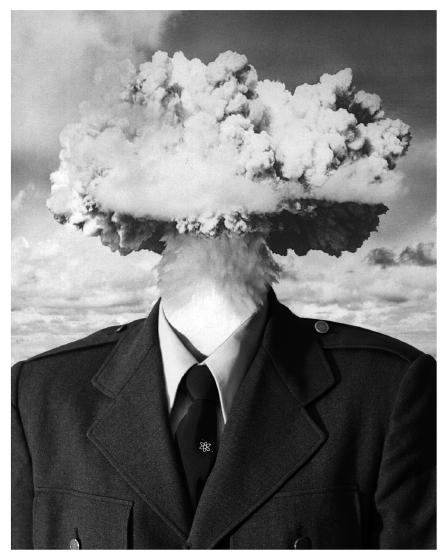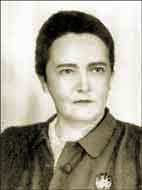A Research Site Devoted to the Past and Future of Found Footage Film and Video

“A lot of people who call themselves artists now are cultural critics who are using instruments other than just written language or spoken language to communicate their critical perspective.”
-Leslie Thornton
Monday, May 5, 2008
Sunday, May 4, 2008
The Soviet Connection

Much of my work has attempted to draw parallels between contemporary video appropriation and transformation on the Internet with avant-garde found footage filmmaking. While I stand by these connections, the contemporary practice, which I call recycled cinema, has much in common as well with Soviet newsreel compilations and re-editing practices.
The use of appropriated footage in Soviet films has been traced back to a French worker from the Lumière factory, Francis Doublier who toured the Jewish districts of Southern Russia in 1898, showing films from his company’s cinematographe. During his tour, Doublier overheard complaints about the lack of images of the Dreyfus case, in its height at the time, and came up with a way of forging images by coupling various film clips of marching soldiers, ships in port and a scene of the Delta of the Nile. Critic Jay Leyda explains the effect:
In this sequence, with a little help from the commentator, and with a great deal of help from the audience’s imagination, these scenes told the following story: Dreyfus before his arrest, the Palais de Justice where Dreyfus was court-martialled, Dreyfus being taken to the battleship, and Devil’s Island where he was imprisoned, all supposedly taking place in 1894.
Doublier, described as “the spiritual ancestor” of Lev Kuleshov, the Soviet montage theorist, uses the metaphoric properties of film to analogize the event where images do not exist. This technique, described by critic Paul Arthur as “metaphoric fabrications of reality” becomes one of the initial attractions to using archival materials in Soviet non-fiction filmmaking.
Two departments of the Soviet film system theorized, experimented and produced what might now be the body of knowledge and practice that have defined the use of found footage in both documentary cinema and the experimental films of Europe and North America since the late 1950s. In the 1920s, the Soviet Export-Import Division of the “The Central State CinePhoto Enterprise (Goskino) founded with an eye, among other tasks, to monopolize distribution” dealt with re-editing films from capitalist countries to reflect pro-communist ideology and made exported films more palatable to international audiences. Newsreel editors, often times also re-editors under the Export-Import division, compiled film for weekly news programs to screen to audiences across Russia. Among these editors were four towering figures of Soviet filmmaking and montage: Lev Kuleshov, Esther Shub, Sergei Eisenstein and Dziga Vertov. Critic Yuri Tsivian writes: “Lev Kuleshov was among the first professional filmmakers engaged in the re-editing of pre-revolutionary films and it was on the basis of his experience as a re-editor that the famous 'Kuleshov experiment’s were devised.” Vertov is described as “the key figure in the early development of Soviet newsreel…” These re-editors were charged with transforming Western films for Soviet audiences both to reflect Marxist ideals and to confirm Soviet suspicions about western capitalism. Many western films were radically altered through sophisticated editing techniques, transformations in intertitles and complete excising of certain characters. Among the various changes re-editors were charged with making:
happy endings would be removed as suggesting that one can be happy under capitalism…"American endings" were generally believed to be forced upon artists by the capitalist film industry'… '[f]at and virtuous people were turned into villains as a general rule…. characters'nationality would be changed…
These daily transformations developed in editors, not only a sophisticated ability to analyze the political meanings of films but also mastery in the area of montage. It was during one such re-edit of Fritz Lang’s Dr. Mabuse that Eisenstein first learned montage under another towering figure of Soviet film editing, Esther Shub. Soviet Filmmaker Sergei Yutkevitch recalls, “Eisenstein appointed himself [Shub’s] voluntary assistant in order to be able to study the construction of Fritz Lang’s montage.” It is here that we may see the birth of a generation of filmmakers rigorously educated in montage and concerned with the critical dialectics of their films. In these state sponsored editing activities the appropriation of film objects appears, purely as an accidental circumstance of the many cut-out shards of films saved by editors. These shards would come to be used in newsreel films or “compilation documentaries” as well as the experimental works circulating between editors and shown at private screenings for laughs.
In addition to these re-edited feature films was what has been variously called the “non-played film,” newsreel film, compilation documentary or the “real film.” In 1905 the Soviet Duma had begun financially supporting regional newsreels under the guidance of the official photographer of the Duma, Alexander Drankov. Once these newsreels were created, Marxist filmmakers, headed by Esther Shub began making passionate calls for a “non-played cinema” to facilitate an analysis and historiography of life under Tsarist rule before the revolution. The exemplary film of this genre is Shub’s The Fall of the Romanov Dynasty (1927). After seeing Eisenstein’s Battleship Potemkin Shub would “seek in newsreel material another film way to show the revolutionary past” by appropriating footage taken by Tsar Nicholas II’s court cameraman. The film, according to Shub was an enormous success with “queues…in all the big cinemas in Moscow.” It was the emergence of films like these that caused Vertov to suggest variously that “the history of Soviet cinema starts with experiments in newsreel film” and support these experimentations as a powerful alternative to film as entertainment when he wrote:
On the moviehouse habitué, the ordinary fiction film acts like a cigar or cigarette on a smoker. Intoxicated by the cine-nicotine, the spectator sucks from the screen the substance which soothes his nerves. A cine-object made with the materials of newsreel largely sobers him up, and gives him the impression of a disagreeable-tasting antidote to the poison.
The diametrical separation between films critically assembled from newsreels and the formalist “played film” frequently appears in the writings of Soviet editors. We may see in Shub’s project the use of film as documentary evidence to intervene and détourn the intentions of the film creator. When Nicholas II’s court cameraman innocently filmed images of dancing aristocrats, it was not for the purposes of contrasting these activities with the toil of ditch diggers that Shub edits into her film. It is Shub’s intervention which radicalizes film fragments that are themselves either apolitical or even counter revolutionary.
Another significant moment in Soviet filmmaking and its relationship to contemporary found footage is observable in a film script by Lilya Brik. Critic Yuri Tsivian notes:
[another] project comes from the pen of Lilya Brik (active in LEF through her connection with Osip Brik and Vladimir Mayakovsky) occasionally involved in script writing, acting and directing. Her first film script (as well as her first film part earlier), The Glass Eye, was a film about filming; her second script is lost, but Lilya Brik remembers it in her memoirs: 'Soon after [having finished The Glass Eye] I wrote a screenplay with a parodie title Love and Duty. The entire story of the film would go into the first reel. The other [four] reels would acquire a completely new meaning as a result of re-editing alone: ... - nothing to do with the original plot. Re-editing alone, not a single shot would be added!'.The style of the proposed film would change from one reel to another: sensational drama (boevik) - a film for teen-aged audiences soviet re-editing - American comedy. In the epilogue, tin cans with film would be shown rolling back to the film factory to be washed off - 'the suicide of film'."
Doesn't this script seem reminiscent of the constant reworking of films by re-cutters and mashers?